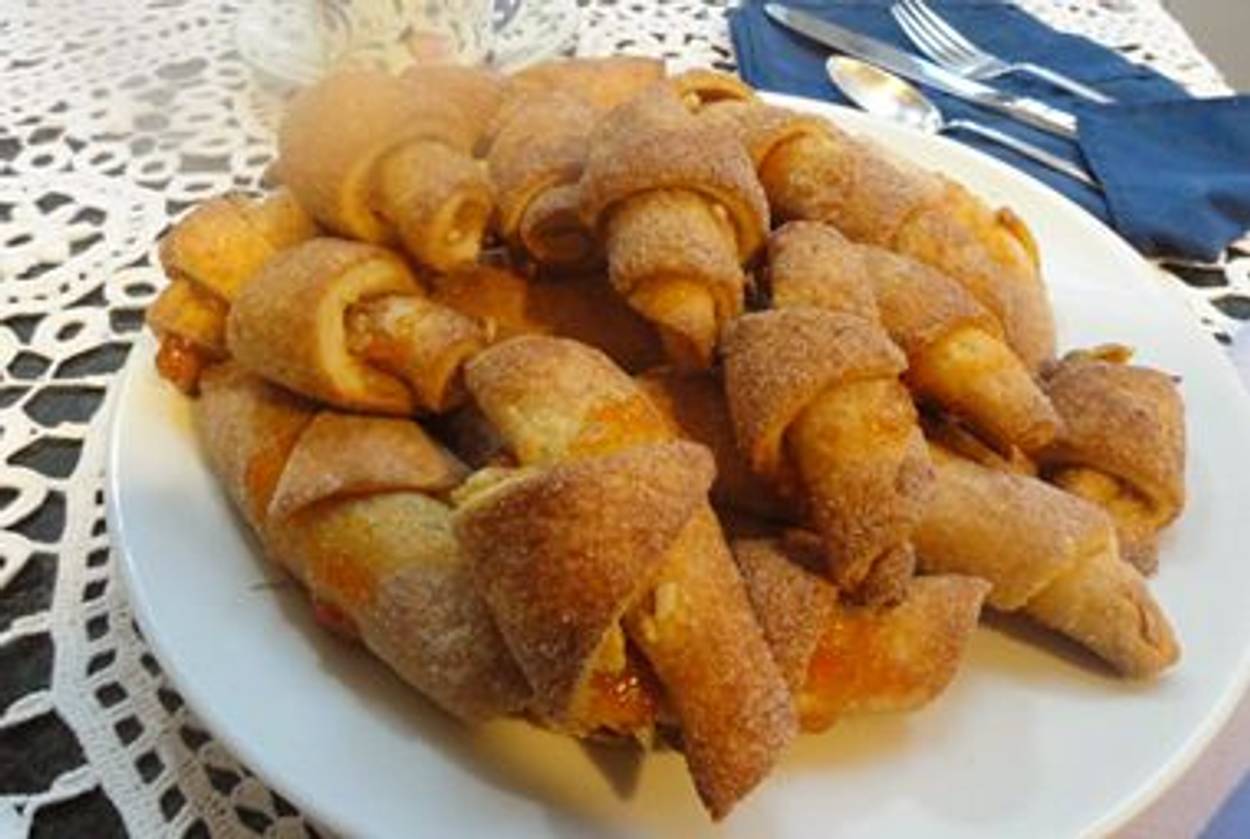Tale of Two Treats
Schnecken and rugelach, though often mistaken for each other and both delicious examples of Jewish baking, are pastries with distinct histories and routes to American popularity




As I traveled the country this fall on my book tour, people shared family recipes with me, as they often do. This time I noticed a theme: rugelach and schnecken, rolled and filled pastries. Rugelach and schnecken are the subject of much confusion in the world of Jewish baking. They are both treats made from the combination of cookie or yeast dough and are filled with different ingredients, like ground nuts, raisins, and jam. But their rich histories are quite different.
Schnecken—the word means snail in German—are made of a rich and sweet yeast dough enriched with egg, sour cream, and butter. The dough is pressed out in a large rectangle shape, sprinkled with sugar, cinnamon, raisins, and ground nuts, and rolled up like a jelly roll. Cut on the cross section, the roll is sliced, baked, and served open-side up in small coiled rounds. Schnecken were very popular as breakfast treats throughout Germany and the Austro-Hungarian Empire, where many bakers happened to be Jewish.
Schnecken are the predecessors to the American sticky bun, the sweet roll, the iconic rest-stop treat Cinnabon, and the delectable pecan roll that I used to eat at Drake’s in Ann Arbor, when I studied at the University of Michigan. The popular Settlement Cook Book documents the evolution of this pastry: The first edition of the cookbook, issued in 1901, includes a recipe for “Cinnamon Rolls or Schnecken”; the 1920 book contains two versions, the original and one for “Cold Water Schnecken“; but by the 1940s the Settlement Cook Book had edited the name of the treat down to simply “cinnamon rolls,” and still later editions find the same yeast dough appearing as pecan rolls baked in muffin pans.
Schnecken arrived in America with Germans and German Jews in the 19th century. One of the most popular schnecken recipes comes from the German Jewish Bake Shop in Cincinnati, Ohio. The United Jewish Social Agencies opened the Bake Shop in 1929 as a venue to provide part-time employment for women, and the place was an immediate success. “It takes them out of their homes temporarily and provides employment for which they are particularly fitted,” the American Israelite reported the year the Bake Shop opened. “Recipes made locally famous by Cincinnati housewives interested in the bakery are being utilized in the making of cakes, cookies and the like.” German Jews who settled in Cincinnati in the years prior to and during World War II often found employment at the Bake Shop and put their own spin on Old World recipes. Although the Bake Shop shuttered in 1966, its schnecken remains a fond memory for some Jewish Cincinnatians.
Classic schnecken are a bit crisper than American sticky buns. They are washed in caramel syrup and baked open-side up in a round or square baking pan. The best I ever tasted was at New York’s renowned William Greenberg Jr.’s bakery on Madison Avenue. Michael London, a former baker at Greenberg’s, now of Mrs. London’s Bakery in Saratoga Springs, New York, showed me how to make the recipe. Just thinking about his schnecken makes me hungry.
In Russia, Ukraine, and Poland, similar pastries were called rugelach. These were rolled in a circle like pie dough, cut in wedges, and then rolled up. Rug means spiral or crescent-shaped in Russian, Ukrainian, and Polish; a miniature spiral-shaped dough was, therefore, a rugelach. In Europe, rugelach were often made from a yeast dough free of sour cream to keep them pareve. Here in America, they are often made with cream cheese. I imagine that someone in the test kitchen of Joseph Kraft worked cream cheese into the cookie dough, thus creating the flaky and rich American version (and a Kraft marketer’s dream). One of the early recipes for cream-cheese dough appeared in The Perfect Hostess, written in 1950 by Mildred Knopf. Mrs. Knopf, the sister-in-law of publisher Alfred Knopf, credited Nela Rubinstein, the wife of the pianist Arthur Rubinstein, with her recipe.
The addition of cream cheese is not the only change that has been made to an old recipe. Stephanie Levine, from New Haven, Conn., who shared her grandmother Bessie’s schnecken recipe with me, explained that her grandmother always made schnecken (or were they rugelach?) filled with raisins and chopped walnuts and topped with cinnamon sugar. At her aunt’s urging, Ms. Levine added raspberry preserves to the filling. Finally, she replaced her grandmother’s filling with one of pecans and golden raisins. Lately I’ll find people who make the cookies with Craisins instead, thus continuing the evolution of an old family recipe.
Mrs. Knopf’s friend Maida Heatter, the pastry chef and author of the wonderful Maida Haetter’s Book of Great Desserts, popularized rugelach with her grandmother’s recipe, which was quite similar to Mrs. Rubenstein’s. Mrs. Heatter’s recipe is the inspiration for both the rugelach found in upscale bakeries and the mass-produced cookie that you’ll see at places like Costco.
It seems that on this side of the Atlantic, schnecken often loses the yeast and the sour cream and became more like rugelach. Sometimes the cookies seem to be only different in name. However, to borrow loosely from Shakespeare, a filled pastry by any other name would taste as sweet. If nothing else, the different names offer the perfect excuse to start the day with a schnecken and end it with a rugelach—what could be better than that?
Joan Nathan is Tablet Magazine’s food columnist and the author of 10 cookbooks including King Solomon’s Table: a Culinary Exploration of Jewish Cooking from Around the World.